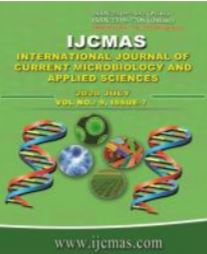


 National Academy of Agricultural Sciences (NAAS)
National Academy of Agricultural Sciences (NAAS)

|
PRINT ISSN : 2319-7692
Online ISSN : 2319-7706 Issues : 12 per year Publisher : Excellent Publishers Email : editorijcmas@gmail.com / submit@ijcmas.com Editor-in-chief: Dr.M.Prakash Index Copernicus ICV 2018: 95.39 NAAS RATING 2020: 5.38 |
Population dynamics of sucking pests of sesame viz. thrips, whitefly, leaf hoppers and aphids were studied. Correlation between the pest population and weather parameters was analyzed and regression equations were developed. Incidence of aphids, leaf hoppers and thrips on sesame crop during kharif season has started on 25th SMW. Thrips (7.3/ plant) attained peak in the 30st SMW, whereas, whitefly population reached peak during 27th SMW with population of 1.7/ plant, whereas, leaf hopper (2.8/plant) and aphid population (12.1/plant) reached the peak in the 31st SMW. Thrips population exhibited significant positive correlation with mean temperature (r=0.501) and non-significant negative correlation with mean relative humidity(r=-0.312) and rainfall (r=-0.498). Whitefly population showed non-significant positive correlation with mean atmosphere temperature(r = 0.285) and mean relative humidity(r = 0.028) and non-significant negative correlative with rainfall (r = -0.452). Leaf hopper exhibited significant positive correlation with mean temperature (r = 0.667) while, non-significant negative correlation with mean relative humidity(r = -0.325) and rainfall(r = -0.296). Aphid population showed significant positive correlation with mean atmosphere temperature(r = 0.667) and non-significant negative correlative with mean relative humidity(r = -0.236) and rainfall (r = -0.444). Incidence of thrips, whitefly, leaf hoppers and aphids on sesame crop during rabi-summer season has started on3rd SMW. Thrips (3.22/plant), white flies (2.48/plant) leaf hoppers (10.1 /plant) and aphids (12.8/plant) reached the peak in the 10th SMW. The correlation between weather parameters and sucking pest population followed the pattern similar to kharif season. Regression analysis data of revealed that the multiple non-linear regression equations are sufficient to predict the pest population with prevailing weather parameters.
 |
 |
 |
 |
 |